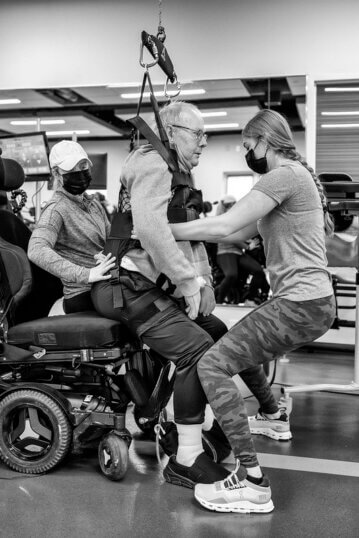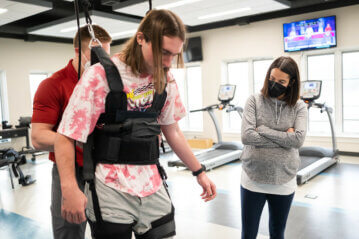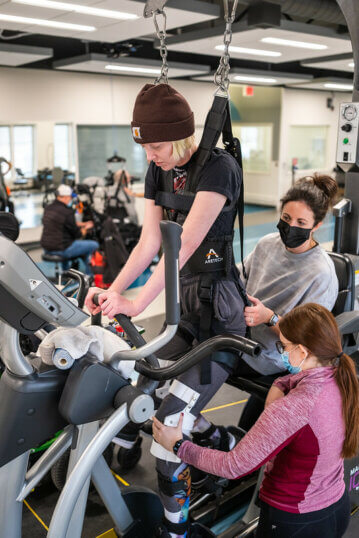The ZeroG®, developed by Aretech, works foremost in aiding clients with gait and ambulation training. As a weight-bearing device, significant constraints that might otherwise be placed on clients or clinicians are greatly lessened. Safety is of paramount concern, and the ZeroG® offers a controlled environment for clients and clinicians to move programs forward and make them stronger.
Weight-bearing support after injury is vital when reestablishing neurological strength and function. Most of us move and walk with 0% weight support, relying solely on our bodies to complete each stride. The neurological connections may be broken after an injury, particularly one involving the spinal cord. Through facilitating neuroplasticity, some of those connections may reform. Certainly, in a post-acute setting, a device or tool that supports weight acts as a vital bridge toward physical progress.
Depending on the severity of a client’s injury, the weight-bearing support provided by the ZeroG® can be utilized in a highly versatile manner. A more “complete” spinal cord injury, for example, will usually result in a greater need for weight support given that the client cannot support much weight independently. The amount of weight support can be easily controlled with the main screen and mobile device connectivity allowing clinicians to open the client’s profile (which contains measurements from previous sessions, such as the number of steps taken while on the track, the overall length of time spent, as well as the amount of weight supported). Because of the ZeroG®’s harness and its ability to quickly and safely arrest a client’s fall, clinicians can guide programs along proactively.
For example, if progress has occurred when a resident has 40% of their body weight supported, a future session may see the clinician lowering that support to 35%, adding a new physical challenge for the client but with goals and parameters that are within reach. The ZeroG® is also excellent in its ability to work in concert with other ambulatory support devices.
One such device is the EVA support walker. It is three-sided with four wheels for ease of ambulation. The left and right sides are fitted with armrest supports where a client can set their arms and then lean forward, gripping two handholds along the front, allowing their weight to be properly supported along this stable platform. When paired with the ZeroG®, it offers an extra safe layer to physical therapy sessions. “If a client is showing great progress using a device like the EVA walker, we can try out a standard walker or even a cane,” says physical therapist Dani Gruber. “Through the ZeroG®, the clients can build repetitions and tackle safe challenges in this environment.”
Repetitions are the key to fostering neuroplasticity, and the ZeroG® is tailor-made for this. Its plastic track affixed to the ceiling in QLI’s Gait and Robotics Lab extends outward for about 65 feet, allowing for a 
The fall-arresting feature of the ZeroG® can be set up in a couple of ways. One way is through a detection of a vertical drop in the height and position of the harness; the other is the detection of an increase in velocity. If a vertical drop or swift increase in velocity is detected, the ZeroG® will catch the client by halting the harness’ momentum. Both the client and harness can return to the previous ambulatory level either through an assisted raise from the ZeroG® motor or through clinician assistance.
Taking repeated steps just for repetitions’ sake only allows for programs to succeed so far. Another key to a client gaining success in ambulation and gait training is proper and stable technique. ZeroG® sessions may involve two clinicians—one to offer rear or forward support (such as gently moving the EVA support walker forward to sustain the client’s momentum), and one to monitor the leg mechanics of each stride. This clinician may follow along on a short, wheeled stool, helping a client achieve proper leg positions in the stride progression (such as guiding a client’s leg forward and up into a slightly bent position and then back down into a more straight and upright position, thus completing half of the stride).
Beyond the repetition of walking in straight lines along the track, the ZeroG® also has select “game
The ZeroG® is just one of many key therapy devices in QLI’s Gait and Robotics for ambulation and gait training. For more on QLI’s Ekso bionic exoskeleton, click here. To learn about QLI’s HydroWorx water treadmill, click here.
Categories: Brain Injury, Gait Training, Neuroplasticity, Physical Therapy, Spinal Cord Injury

